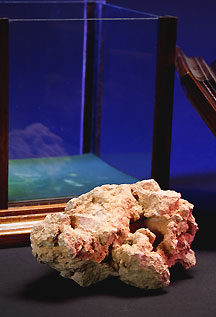|
(page 3 of 3)
What do these combinatorial libraries look like? These
10,000 different compounds?
Yes, we have published papers on the 10,000 member libraries,
as you know. What inspired us there was, in looking in the
literature at natural products for medicinal chemistry, we
recognized that there were a great number of naturally occurring
compounds and medicinal compounds [with common structures].
And they were endowed with a variety of biological effects,
including anti-cancer, antibiotic, antiviral, enzyme inhibitory
and so on.
So immediately, we felt that instead of waiting for people
to go and collect these compounds from nature, one at a time,
we could design a strategy in which we could produce them
in the laboratory in large numbers, and make relatives of
these compounds, analogues of these compounds. We call these
libraries.
The universe of molecular diversity, as we call it, is huge—essentially
unlimited. The wise thing to do is to design sub-libraries.
From this huge universe of molecular diversity, we design
a sub-library, say, looking like vancomycin, or the epothilones,
or like nothing you’ve seen before—something that
you’ve just imagined—but within the domain of structural
variation that you can make through the same synthetic technology.
Yet you can have a variation of 10,000 compounds. Then once
you’ve done this library, you can start over from scratch.
Totally different structures, again, but within a framework,
a scaffold.
In the last decade, you and your lab have synthesized
rapamycin, vancomycin, taxol, brevetoxin, epothilones...
And calicheamicin. Don’t forget calicheamicin. That’s
an important one. 1992.
This compound came out of a rock. It was collected at Waco,
Texas, in 1987 by a touring scientist. He picked up this rock
thinking, "Maybe there’s some bacteria or fungi living
inside." So he brought this rock to the laboratory and grew
a culture. Inside this culture they discovered a compound
called calicheamicin. A phenomenally active compound, extremely
active against tumor cells—it binds to DNA, chops it
into pieces, and kills the tumor cells.
It was too toxic to be used as a medicine, but the structure
was so beautiful, so unusual, and unprecedented—it looked
impossible to synthesize. We had the courage to try to make
this compound, and we synthesized it in 1992. Then, after
several years, people in industry attached this compound to
antibodies so they were able to deliver it to certain cancer
types selectively without the side effects of the very toxic
compound. And it’s now in the clinic. It’s been
approved by the FDA. Certain types of lymphomas, I believe,
can be attacked by conjugates of the calicheamicin with the
antibodies. The story of this compound is fascinating, and
I’m very proud of it.
So what’s next?
That’s a good question. Everybody’s been asking
me the same question for the last 10 years. "What’s next?"
It’s like the stock market: what should we buy next?
[LAUGHS]. If I knew, I’d be a much more famous chemist
than I am today.
Let me ask you a more general question then. In looking
to the 21st century, what are the big synthetic targets for
you and for others in the field?
Well, I think the best targets in the field are going to
reveal themselves to us in the future. We have only just touched
the tip of the iceberg in terms of molecular diversity from
nature. A lot of the structures that we have synthesized were
not known to us 10 years ago. I strongly believe that we are
going to see a lot of new structures creeping into the literature
with exciting biological activities that will keep us busy.
I consider myself very fortunate to be in such an exciting
field. It’s not necessarily that we will discover the
miracle drugs of tomorrow, but the basic science that we develop
is the kind that is used in the pharmaceutical and biotechnology
industries to invent and discover the new generation of medicines.
The training that we provide to the students is very instrumental
for that. It’s basically the collection of the accomplishments
of my students that I am most proud of. And instilling in
these students the habit of rational and deep thinking required
by such projects, an invaluable companion for their future
careers.
Is there anything else?
It’s very important to give credit to all my team—my
students, my staff, Vicky Nielsen, Janise Petrey, my colleagues
in the chemistry department, and our administration here,
especially Richard Lerner [president of TSRI] for his visionary
moves and his generosity and support over the years. We couldn’t
have done what we have done in the chemistry department without
his support.
1 | 2
| 3 |

|

A rock, above, collected by a touring scientist in Waco, Texas,
yielded calicheamicin, below, a compound extremely active
against tumor cells. "We have only just touched the tip
of the iceberg in terms of molecular diversity from nature,"
says Nicolaou.

See also:
•
The Nicolaou lab web page
•
The
Art and Science of Total Synthesis at the Dawn of the Twenty-First
Century
|

